$8.6 billion valued crypto FBI, Chainalysis escorts government and institutions
Author: Ting Cheng Tianyi, Overseas Unicorn
Palantir helped the CIA track down Osama bin Laden over a decade ago, while Chainalysis has enabled government agencies like the FBI and IRS to extend their investigative and law enforcement capabilities to the blockchain.
Chainalysis was founded in 2015 by former Kraken COO Michael Gronager and others. At that time, the Mt. Gox exchange had already experienced a significant loss of funds, and Bitcoin was almost synonymous with hacking, online drug trafficking, and terrorism. Based on on-chain public data, tagged data, and machine learning models, Chainalysis's product matrix allows clients (from prosecutors and FBI agents to compliance personnel at exchanges) to deeply investigate any on-chain transaction and its related transactions, as well as monitor transactions in real-time to meet compliance requirements such as anti-money laundering, attempting to establish trust in blockchain.
In May 2022, Chainalysis announced the completion of a $170 million Series F funding round led by GIC, with a valuation reaching $8.6 billion. Other shareholders include institutions such as Benchmark, Accel, Paradigm, and Coatue. It has over 750 clients in 70 countries and regions, with 150 clients contributing over $100,000 in ARR.
Many people perceive Chainalysis as "doing government business," but its private enterprise revenue has accounted for over 40% since 2019, becoming an essential compliance tool for clients such as exchanges, stablecoin issuers, NFT trading platforms, and even crypto-friendly banks.
Chainalysis's ARR has doubled year-over-year in recent years, with NDR reaching as high as 140% and gross margins exceeding 80%, aligning with the characteristics of typical high-growth SaaS companies. It is no longer satisfied with remaining in compliance and risk control scenarios, having launched multiple BI-type data products in 2021, attempting to enter the operational aspects of clients' daily businesses.
In this article, we mainly view Chainalysis's business from the perspective of growth-stage investors, while the question of whether the emergence of regulatory technology companies like Chainalysis contradicts the original intention of Bitcoin and the crypto ecosystem may be an open question with differing opinions.
1: Thesis
The reasons that attract us as growth-stage investors to pay attention to Chainalysis are mainly as follows:
Market
On-chain transactions are not lawless; government agencies are willing to pay for new regulatory and enforcement challenges. Due to the anonymity and irreversibility of on-chain transactions, they are widely used for illegal activities such as dark web trading, extortion, terrorism financing, and money laundering. The regulatory and enforcement needs of governments regarding these activities have long existed, and the simple and user-friendly data products and investigative services built by Chainalysis can attract significant projects and large contracts from them.
As regulations improve, financial institutions and crypto-native companies also have strong compliance needs. From Europe and the US to the Asia-Pacific region, the KYC and AML (anti-money laundering) regulatory frameworks surrounding crypto assets are becoming increasingly refined. Whether it is exchanges like Binance, fintech applications like Robinhood, or traditional financial institutions like Barclays, as long as they handle crypto assets, Chainalysis is a compliance necessity. The number and scale of these private sector clients have rapidly developed over the past two years.
Competitiveness
Chainalysis started early and has deep accumulation, possessing the industry's most established and reliable datasets. Chainalysis builds models using machine learning, and the quality of its datasets is its core competitive advantage. It began systematically building datasets related to illegal activities in 2014, scraping information from thousands of websites, dark web forums, and scam databases, currently holding billions of address tags from over 6,500 service providers. The daily transaction data and KYC information from its KYT-connected exchange clients create a positive feedback loop for data accumulation.
Chainalysis has participated in the "largest, fastest, and most important" cryptocurrency law enforcement events. Chainalysis is similar to CrowdStrike or Palantir in the crypto field, known for its involvement in the most significant investigative events: it helped creditors of Mt. Gox trace the whereabouts of hundreds of thousands of Bitcoins, assisted the Department of Justice in shutting down the largest child pornography site Welcome to Video, and participated in the Silk Road dark web $1 billion seizure operation… These best practices have supplemented Chainalysis with unique data sources and helped it build inherent trust among overseas government and private sector clients.
Chainalysis's SaaS metrics perform excellently, resembling a software product company rather than a project service company. Chainalysis's ARR has doubled year-over-year in recent years, with NDR reaching as high as 140% and gross margins exceeding 80%, aligning with the characteristics of typical high-growth SaaS companies. At the same time, Chainalysis's private enterprise revenue has surpassed government orders and successfully expanded its customer base in the Asia-Pacific region, validating the scalability of its business. Throughout this process, its NPS has consistently remained above 80.
Team
The CEO is a crypto-native serial entrepreneur who has experienced bull and bear markets. Founder and CEO Michael Gronager previously served as CEO of Nordic DataGrid Facility, the world's largest distributed storage installation company at the time, and later as COO of Kraken, the crypto exchange that emphasizes security, experiencing three waves of bull and bear markets since 2013.
Chainalysis's team has established sustainable close relationships with regulatory agencies. Chainalysis built strong government relationships early on, with its first demo presented to Katie Haun, and Benchmark's investment in Chainalysis's Series A was also introduced by her; former Deputy Secretary of the Treasury Sigal Mandelker participated in Chainalysis's investment and served as an advisor after joining Ribbit Capital, having previously coordinated counter-terrorism, anti-money laundering, and financial intelligence during her government work.
2: Market: Illegal Activities Love Cryptocurrency
Chainalysis operates in a vertical industry market, acting as a bridge between exchanges, financial institutions, regulatory agencies, and law enforcement agencies, using deep analysis and machine learning to help law enforcement investigate illegal transactions and ensure financial institutions comply with AML.
The scale of this market is difficult to model because it heavily relies on our belief in the overall development of the crypto market and has strong reflexivity—whether regulatory infrastructures like Chainalysis can receive funding will, in turn, determine the development trend of the crypto ecosystem. Overall, the potential market size for Chainalysis is unrelated to cryptocurrency price fluctuations and mainly depends on the number of governments and private enterprises entering this field and the number of transactions.
However, the pain points in this market are very clear: with the emergence of Bitcoin, various illegal activities around the world seem to have found the most suitable payment and transaction methods. In 2021, $14 billion worth of cryptocurrency was used for illegal activities, an increase of over 80%. The IRS's Criminal Investigation Division seized over $3.5 billion worth of cryptocurrency in 2021.
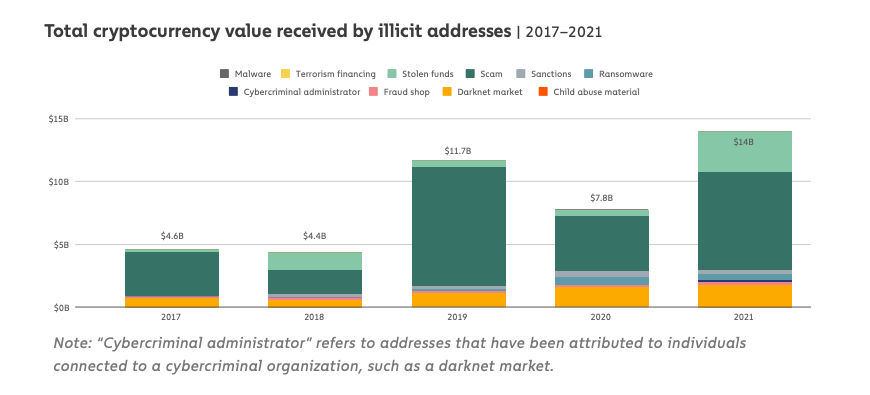
This includes the migration of traditional illegal payment methods—P2P, anonymous, and irreversible payment methods perfectly meet the needs of criminals.
- Fraud: This is the largest form of crime by monetary volume, with victims losing $7.7 billion worth of tokens to fraud in 2021. In addition to traditional online fraud, the crypto world has also evolved new types of scams such as Rug Pulls (where DeFi or NFT project teams abandon the project and run away with the money) and Ponzi collapses.
- Dark Web Trading: Online black markets like Silk Road are the most typical examples. Criminals trade drugs, stolen credit cards, and even hire killers on these platforms, with Bitcoin being a common payment method. Such transactions generated over $2 billion in cryptocurrency proceeds in 2021.
- Ransomware: Criminals send emails or ransomware to victims, using their fear to force them to pay a ransom to protect their privacy or regain control of their computers. Ransomware activities generated $600 million in illicit proceeds in the crypto world in 2021.
- Terrorism Financing: This includes funding terrorist organizations in cryptocurrency, with the team that received the most funding in 2021 being the Palestinian armed group Hamas, while in previous years, groups like ISIS, Al-Qaeda, and Malhama Tactical were also involved.
- Child Exploitation Material: Cryptocurrencies like Bitcoin are one of the mainstream payment methods for obtaining child pornography.
- Funding for Sanctioned Countries: Countries like North Korea, Russia, and Iran are sanctioned by many countries and international organizations; they may obtain crypto assets from certain counterparties or steal tokens through hacking.
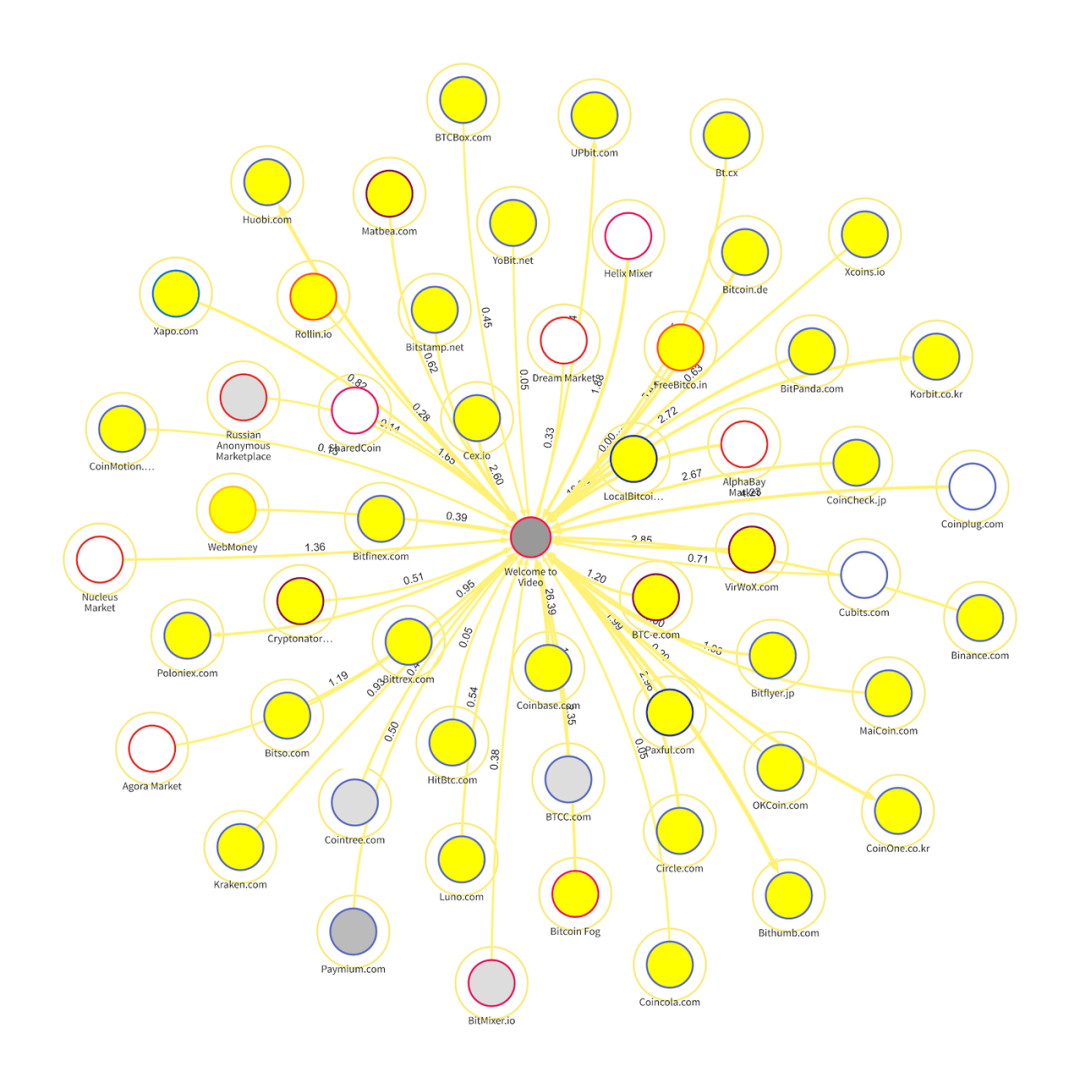 Chainalysis Reactor helped law enforcement analyze the flow of funds in the on-chain addresses of the child pornography site Welcome to Video.
Chainalysis Reactor helped law enforcement analyze the flow of funds in the on-chain addresses of the child pornography site Welcome to Video.
It also includes crypto-native issues:
- Theft: This includes methods such as information theft, clipboard attacks, and malware to steal others' private keys, as well as Cryptojacking, where hackers invade others' computers to mine for profit. This not only threatens individual holders but also centralized exchanges, DeFi protocols, cross-chain bridges, and other entities holding tokens or locked funds in contracts. In 2021 alone, over $3 billion worth of tokens were stolen.
In the early days, these illegal activities constituted the vast majority of cryptocurrency use cases. However, with the emergence of more financial service use cases and the Web3 narrative, the crypto ecosystem is stepping into the sunlight, but these dark use cases have suppressed its mainstream development—exchanges have long been unable to open bank accounts due to compliance issues, financial institutions fear that accepting cryptocurrencies will damage their reputations, and regulatory and enforcement agencies have been at a loss regarding new technologies for a long time.
Ribbit Capital partner Sigal Mandelker experienced this process as a regulator and enforcer. After joining the U.S. Treasury as Deputy Secretary in 2016, some of the projects she oversaw included curbing North Korea's weapons of mass destruction and Russia's terrorism.
She observed that cryptocurrencies were playing an increasingly important role in these activities, but for a long time, only a few countries like the U.S., South Korea, and Japan had well-developed regulations, while many regions' financial scrutiny capabilities hampered their work. Regulatory technologies represented by Chainalysis can fill the gaps in everyone's capabilities, allowing the crypto ecosystem to promote financial service inclusivity and humanitarian aid.
3: Origins: Making Prosecutors More Willing to Choose Crypto Cases
The Mt. Gox incident was a pivotal event that shaped today's crypto ecosystem, comparable in impact to the earthquake triggered by Terra/UST in 2022, giving rise to the awareness of self-custody and RegTech companies like Chainalysis.
dForce founder Miao Dao described this incident on Twitter:
Mt. Gox was the world's largest Bitcoin exchange from 2010 to 2013, peaking at a trading volume that accounted for 70% of the global total; today, the combined volume of the top 10 exchanges does not match its size. It filed for bankruptcy in February 2014, losing 850,000 Bitcoins over three years, recovering only 200,000, with nearly 650,000 Bitcoins missing (currently valued at $20 billion), leading to the exchange's bankruptcy liquidation. Mt. Gox users covered over 50% of Bitcoin players globally, many of whom lost everything.
Chainalysis CEO Michael Gronager joined the most security-focused exchange, Kraken, as COO in April 2013, when Bitcoin rose from $10 to $1,000.
Then the bankruptcy of Mt. Gox occurred.
Michael Gronager still believes that cryptocurrencies represented by Bitcoin are the most transparent financial systems ever, but at that time, they were almost synonymous with hacking, online drug trafficking, and terrorism. He spoke with banks and regulatory agencies in the U.S., Europe, and Asia and discovered their pain points in monitoring transactions, understanding fund flows, and investigating cases. He decided to leave Kraken to address these pain points.
On a flight back to Europe from Kraken's San Francisco office, he wrote 50 lines of code, completing the initial Proof of Concept for Chainalysis.
*The key point that made Chainalysis's PoC viable lies in the actual pseudo-anonymity and transparency of Bitcoin.
In cash scenarios, you can submit SARs (Suspicious Activity Reports) for those carrying a bag of cash into a bank.
In the digital payment scenario, there are established vendors like ComplyAdvantage and emerging companies like Unit 21 serving anti-money laundering scenarios. They can connect various AML rules to clients' transactions and allow them to customize their own rules, often providing a Case Management system to handle risk alerts and submit SARs.
In cryptocurrency, the difficulty of anti-money laundering is somewhat lower—most criminals do not actually exchange drugs for a bag of cash at the bank; once they trade behind a wall, it becomes challenging to monitor money laundering operations. The distributed ledger technology used by BTC and mainstream cryptocurrencies gives us a "x-ray vision," as every on-chain address and its transaction records are public and permanently exist, and suspicious transaction behaviors, trading addresses on the dark web, their associated addresses, and KYC records of certain addresses at exchanges can help us link on-chain addresses to corresponding entities.
He then found his CTO Moller, who built the underlying database and API in January 2015, and outsourced a UI version. Once this series of work was completed, Chainalysis's demo was first presented to Katie Haun, who was then the Deputy District Attorney for Northern California and was handling a cryptocurrency-related case with two FBI agents.
Chainalysis was deeply involved in the investigation of this case, allowing it to understand early on what kind of products regulators and law enforcement needed. Additionally, Chainalysis was a member of Barclays Bank's accelerator program Techstars at the time, which allowed the team to understand the thoughts of financial institutions from Day One.
Subsequently, Chainalysis participated in the investigation of the Mt. Gox theft case, where Michael Gronager encountered another co-founder, Johnason, and gained fame again in 2017 for tracing the whereabouts of the missing Bitcoins.
Having tools like Chainalysis changed the attitude of prosecutors and agents towards cryptocurrencies, as Sigal Mandelker expressed to Wharton FinTech:
If there are now three money laundering cases for prosecutors to choose from: cash, shell companies with offshore bank accounts, and cryptocurrencies. Generally, they would be more willing to choose the money laundering case involving cryptocurrencies.
4: Products: Building a Product Matrix Based on Data Advantages
Chainalysis initially started with Reactor for retrospective analysis used in law enforcement investigations, and with the expansion of clients and deeper integration into clients' operational stacks, it now has five products that cover not only compliance and risk control scenarios but also business scenarios.
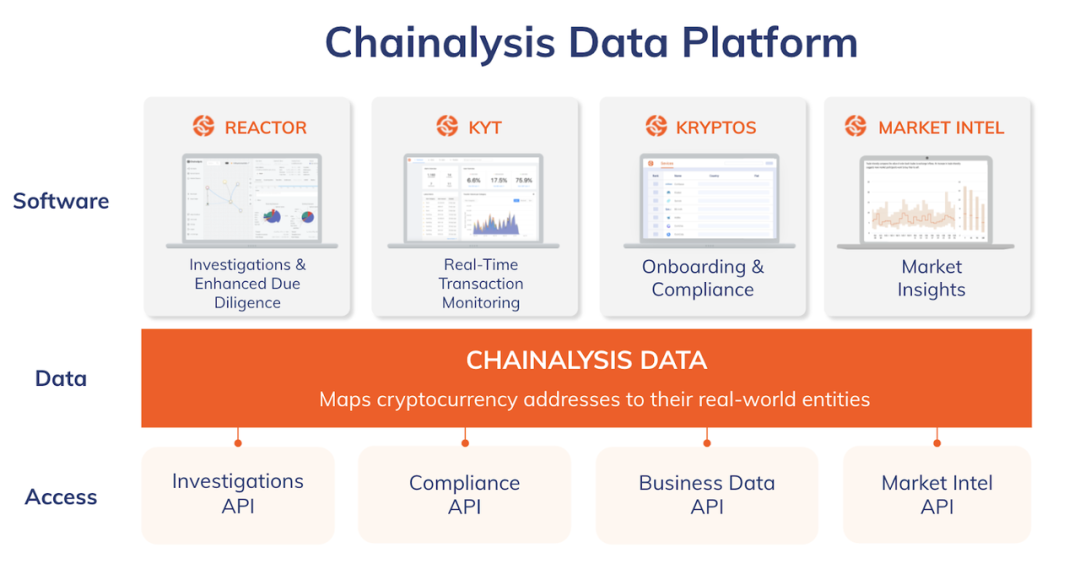
Overall, we believe that Chainalysis's product development history and strategic choices have the following characteristics:
- Core focus on underlying data assets: After recent funding rounds, Chainalysis has emphasized that the primary use of funds is to strengthen data advantages, mainly because the volume of new data in the crypto world is large and time-sensitive; some data may become ineffective in a few months, so Chainalysis needs to continuously invest in data assets (especially those with relatively long-lasting effects);
- Keeping up with the evolution of the multi-chain era: Chainalysis initially focused on Bitcoin, while new public chains like Ethereum introduced smart contracts, increasing the difficulty of analyzing transaction execution addresses, and their account systems are very different from Bitcoin's UTXO design. Chainalysis has not fallen behind in the evolution of the multi-chain landscape and is actively providing clients with panoramic capabilities across multiple chains;
- Actively adapting to various on-chain innovations: Criminal methods are not static and often evolve with innovations in DeFi, NFTs, cross-chain bridges, etc. Chainalysis actively adapts to these innovations and can help its exchange clients onboard new tokens more quickly by identifying the risks associated with on-chain assets;
- Continuously deepening into clients' operational stacks: Compliance is a cost for many private enterprises, merely to meet regulatory requirements. Chainalysis is attempting to position itself as both a cost item and an investment item, deeply participating in the daily operational aspects of enterprises through new industry analysis and business data analysis tools.
Case: Chainalysis Helps the FBI Recover Colonial Ransom
We can first understand how Chainalysis's law enforcement investigation capabilities work through a case.
On May 7, 2021, the U.S. oil pipeline company Colonial Pipeline was attacked by ransomware, forcing it to temporarily halt operations. Within hours of the attack, Colonial paid a ransom of 75 Bitcoins (worth about $4.4 million at the time) to the Russian cybercrime group DarkSide. However, Colonial did not resume operations until six days later.
Chainalysis helped the FBI recover $2.3 million worth of Bitcoin from Colonial's ransom.
The specific fund tracing process is as follows; FBI agents can see similar fund flow charts in Chainalysis Reactor:
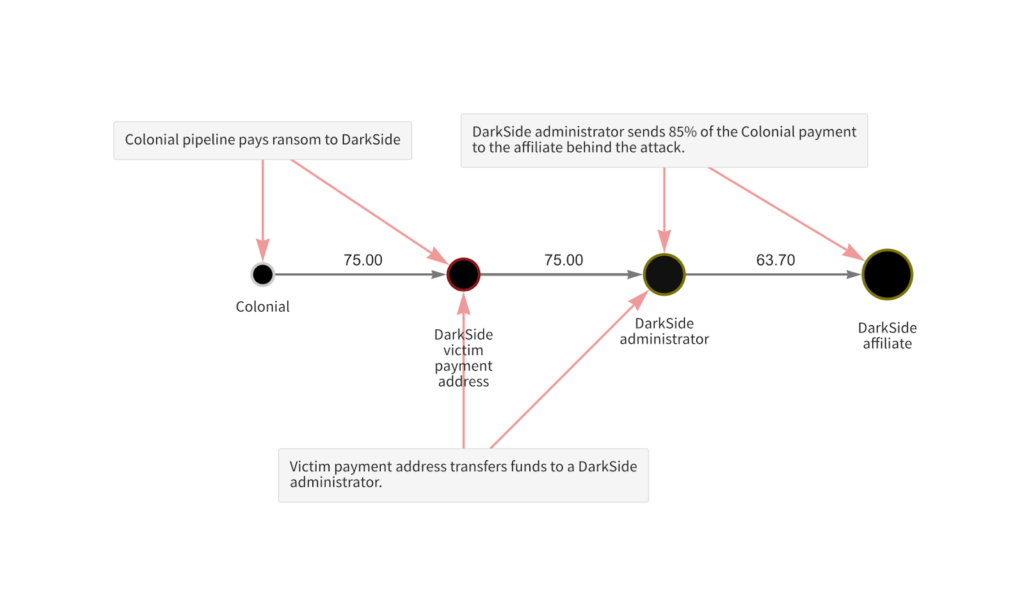
Colonial first transferred 75 Bitcoins to the address provided by the attackers. Then these illicit funds were transferred to the DarkSide admin's address, and the admin only transferred 85% of the illicit funds (63.7 Bitcoins) to the DarkSide affiliate. This profit-sharing method indicates that DarkSide provided RaaS (Ransomware as a Service), and this affiliate used its technology to carry out the attack.
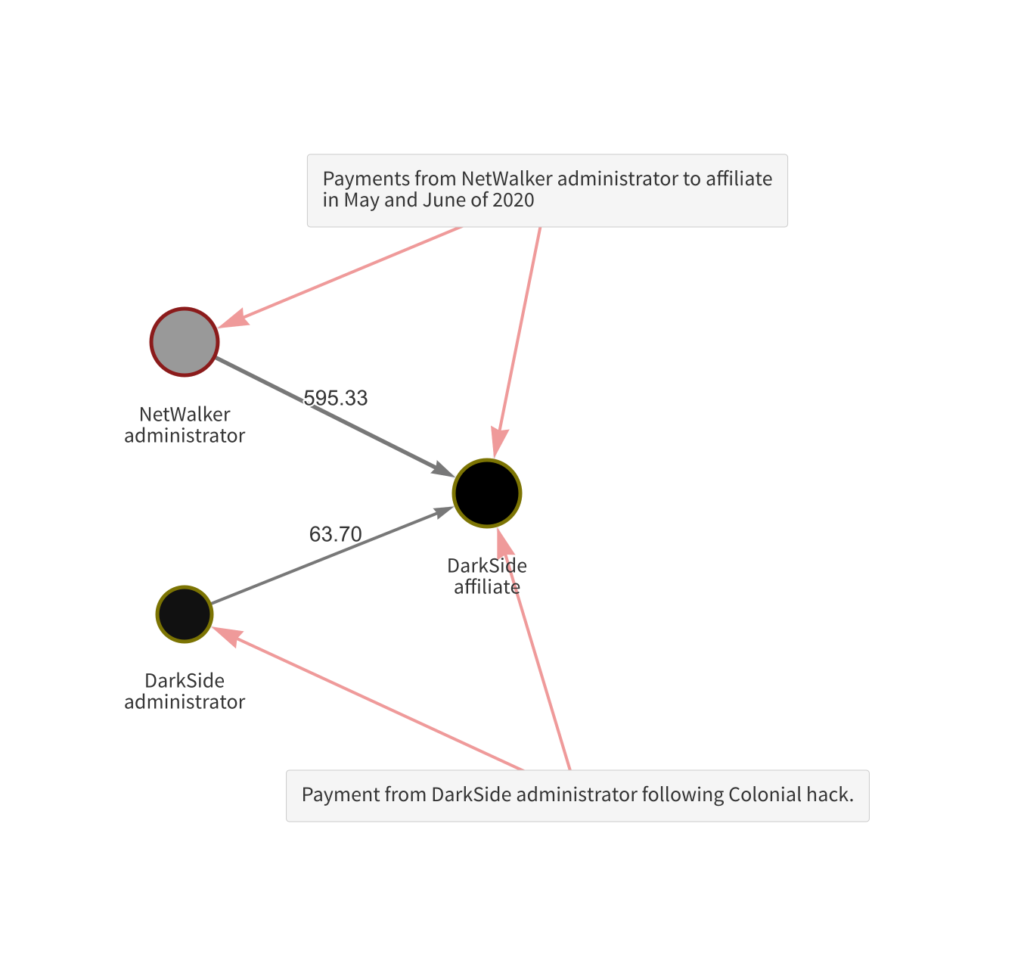
This DarkSide affiliate's address had previously received payments from addresses related to NetWalker. NetWalker is another RaaS software that was taken down by law enforcement in January 2021. This provided clues for FBI agents, who seized the illicit funds on May 28, 2021.
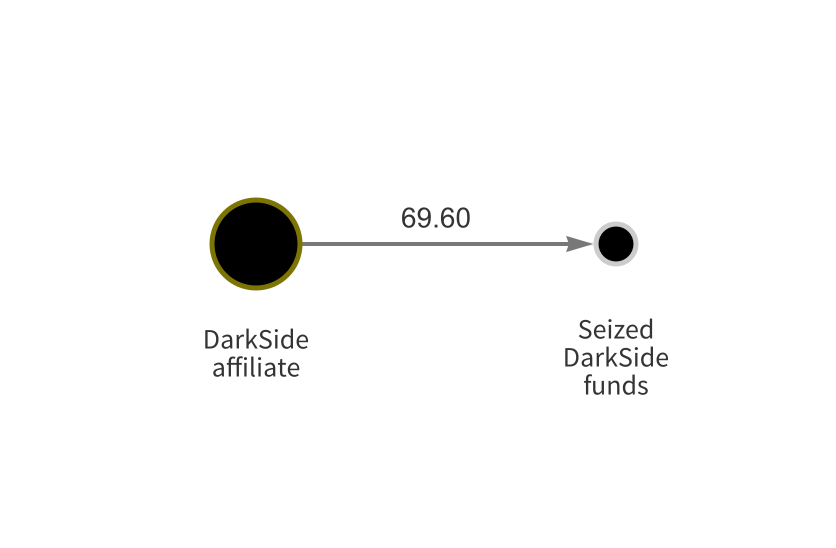
Matrix Expansion: Gradually Deepening into Clients' Operational Aspects
The launch of several of Chainalysis's products has clear chronological order and strategic considerations:
The Oldest and Core Chainalysis Reactor
The products Chainalysis sold from 2015 to 2018 were primarily Reactor, and until 2018, 90% of its revenue came from law enforcement agencies. This is mainly because Reactor provides retrospective analysis of transactions, so early clients primarily used it for investigating existing cases.
Reactor can be seen as a "visual blockchain map" or an "enhanced on-chain due diligence product." The child pornography site Welcome to Video and the Colonial ransomware case we showcased above are typical use cases for it.
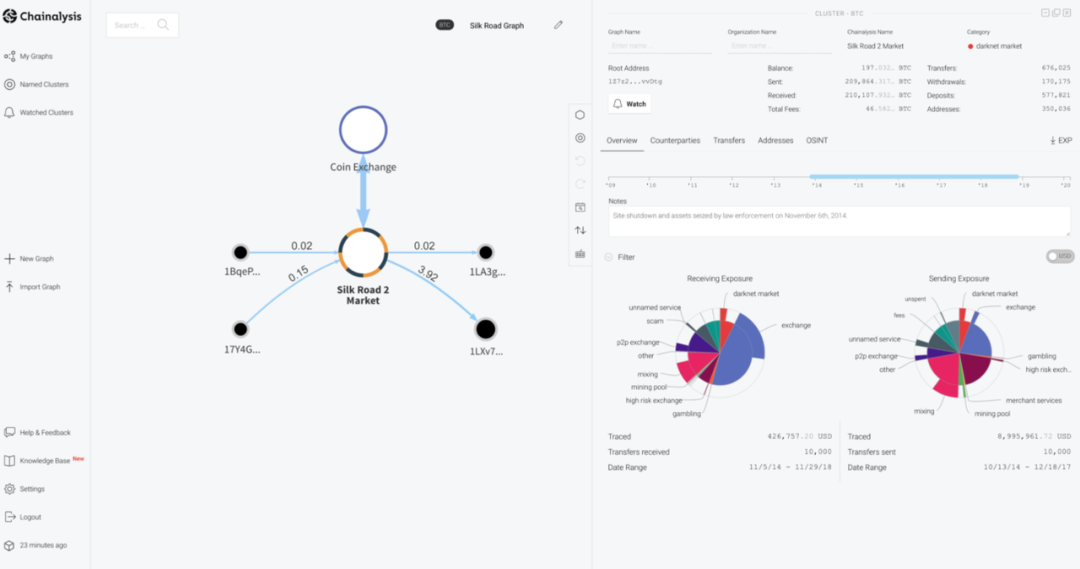
This product's underlying data set includes on-chain public data, real-world tagged data obtained by Chainalysis (linking on-chain addresses to dark web, scammers, ransomware, DeFi platforms, mining pools, and other legal or illegal entities), and outputs from its machine learning models.
Reactor is a user-friendly product; Chainalysis has maintained the simplicity of the product over the past few years while adding capabilities related to on-chain innovations, such as cross-chain investigation charts and DeFi activity monitoring.
Chainalysis KYT for Enterprise Clients
Chainalysis KYT is largely similar to traditional anti-money laundering transaction monitoring software. It provides a web-based dashboard and real-time monitoring API, helping clients automatically comply with local and global anti-money laundering regulations and sanctions lists, track fund flows, and expose risks.
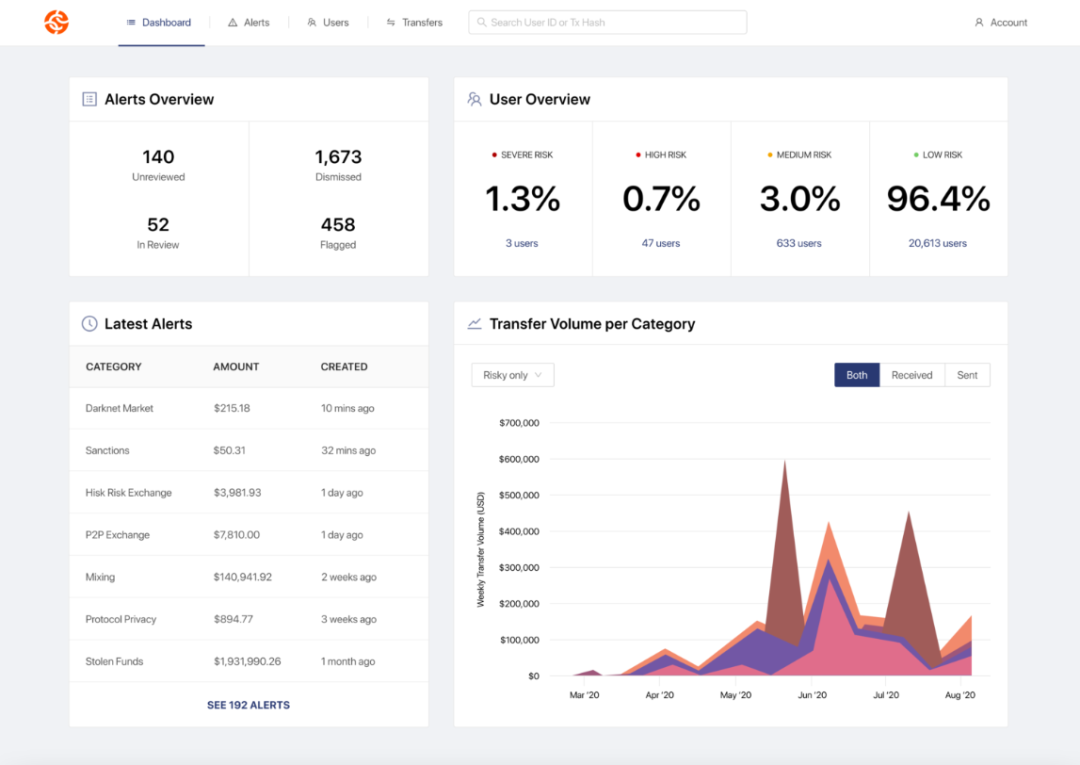
This product was launched in 2018 and quickly went to market on a large scale, primarily targeting exchanges and stablecoin issuers, signing major clients like Binance and Paxos very early on. This helped improve Chainalysis's client structure, reducing government client revenue to 40%.
Like new-generation anti-money laundering software such as Unit 21, Chainalysis KYT is more flexible and supports clients in customizing their own high-risk activity rules. For example, gambling companies may be considered illegal and high-risk in certain regions but legal in others.
The bull market in the second half of 2017 was a significant driver for the development of this product. Chainalysis co-founder Levin stated at the time:
In 2014, the user base of exchanges was very small. They could manually set rules and review them. But now, the new users they attract each week exceed all users at that time, so they need automated review tools for millions of users. And this is real-time, without waiting 30-45 minutes.
Many clients purchase both Chainalysis Reactor and KYT simultaneously; for example, Dapper Labs uses KYT to mark illegal and high-risk transactions in real-time and uses Reactor to query and investigate certain specific transactions. Once these clients use KYT, Chainalysis can further strengthen its data advantages through their transaction data.
Kryptos for Financial Institutions
In addition to these two core compliance products, Chainalysis launched Kryptos in 2020, expanding its cross-selling capabilities—its existing banking and asset management clients are often not very familiar with the cryptocurrency ecosystem, so Chainalysis Kryptos provides them with intelligence about the entire market, including market trends, counterparties, and specific asset situations, helping these clients establish compliance and risk control frameworks around cryptocurrency services.
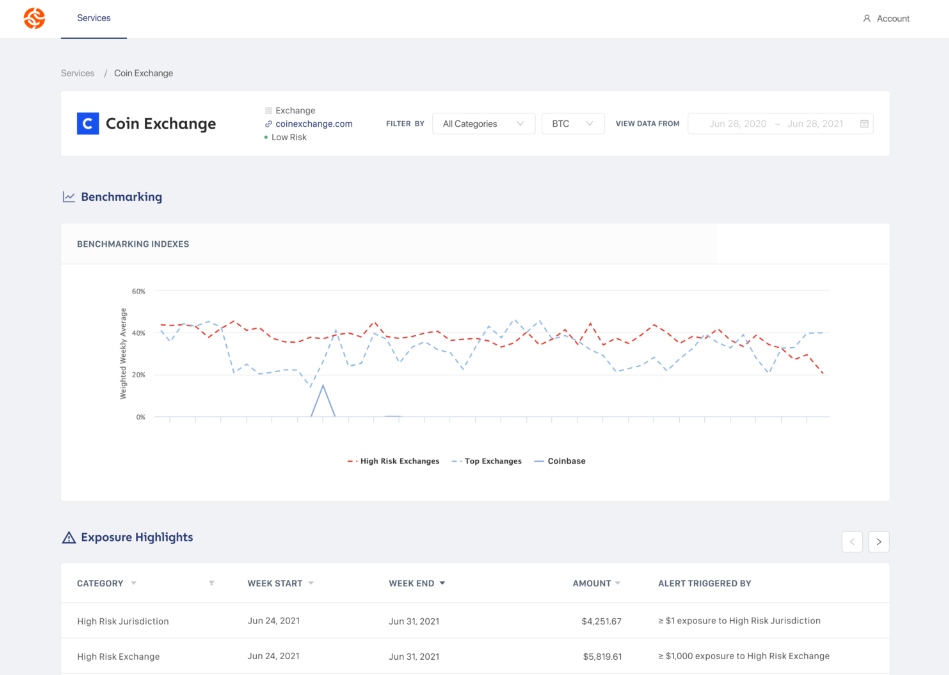
Market Intel and Business Data Entering Business Scenarios
These two products were newly launched by Chainalysis in 2021, having transitioned from compliance scenarios to everyday business scenarios.
Market Intel helps clients make investment decisions by providing more transparent and visual market data, while Business Data is similar to enterprise BI, attempting to answer questions for clients regarding new customer target groups, asset pricing strategies, channel analysis, and customer whereabouts.
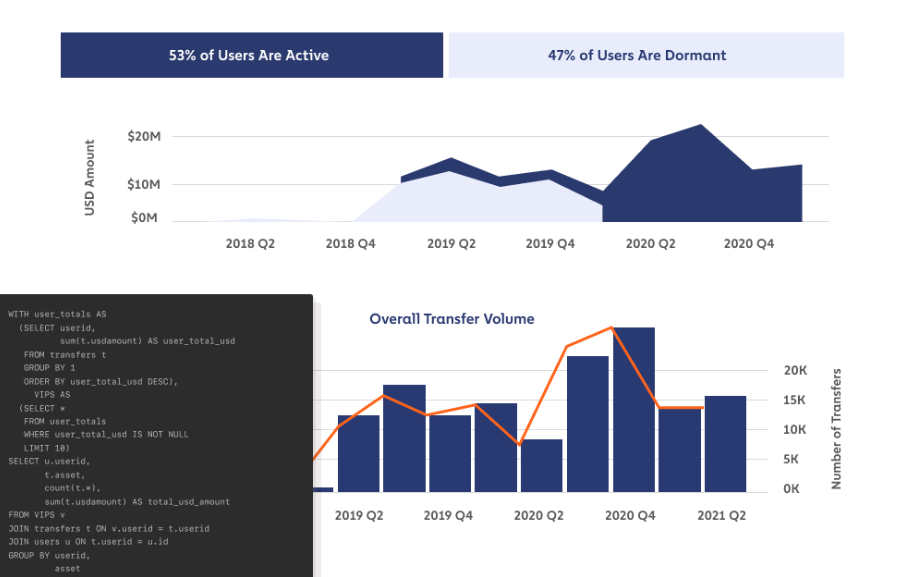
Chainalysis Business Data can be integrated as a data source into clients' data warehouses, helping clients gain deeper insights into user behavior. On this basis, Chainalysis also provides expert services from data scientists to assist clients in analysis.
Phoivos Mytilinaios, Head of Business Intelligence and Data Engineering at European digital asset platform Bitpanda, stated:
Chainalysis's data-driven products have also expanded beyond compliance; they will help us formulate marketing and product development strategies to expand and retain our customer base.
This is a relatively imaginative business that will determine whether Chainalysis remains just a RegTech company or becomes an OS-level product in the cryptocurrency space—tapping into more customer budget categories. We look forward to observing more business progress to assess Chainalysis's breakthroughs in this area.
Revenue Model: Government Contracts and Recurring Income
We do not have access to Chainalysis's detailed data room, but companies providing on-chain data services typically charge clients through minimum annual fees and usage-based API calls. Chainalysis primarily serves government and large enterprise clients, and the corresponding solutions are often complex, so the overall revenue model is not singular.
In terms of revenue nature, Chainalysis has a To-G attribute, thus having contract revenue and recurring software revenue. Revenue contributed by non-government clients has significantly improved since 2019.
According to Forbes estimates, Chainalysis had about $8 million in revenue in 2018, with the founder's expectation of doubling each year. However, due to the explosive bull market from 2020 to 2021, it already had over $40 million in ARR in 2020, and its ARR in 2021 likely exceeded $100 million.
Chainalysis raised a significant amount of funding during this bull market, maintaining a rhythm of raising $100 million almost every quarter since Q4 2020, with its valuation soaring from $1 billion at the end of 2020 to $8.6 billion in 2022.
Until the end of 2020, Chainalysis had not yet achieved profitability. However, the CEO stated at the time that the company's burn rate was very low and profitability would be achieved soon. We are currently uncertain whether subsequent financing has changed his perspective, as Chainalysis's employee count has risen from 200 at that time to a planned 700 now.
5: Clients: Expanding from Government to Various Private Enterprises
Chainalysis has built solutions for investigations, compliance, DeFi, NFTs, etc., resulting in a highly diversified client base. Currently, it has 750 clients in 70 countries, with 150 clients contributing over $100,000 in ARR.

Government remains Chainalysis's most important client group, having penetrated various regulatory and law enforcement agencies in the U.S. Due to the relationship between the Chainalysis team and regulatory agencies, as well as the training and other costs incurred by federal, state, and local governments for using Chainalysis, these departments will maintain a strong stickiness to Chainalysis.
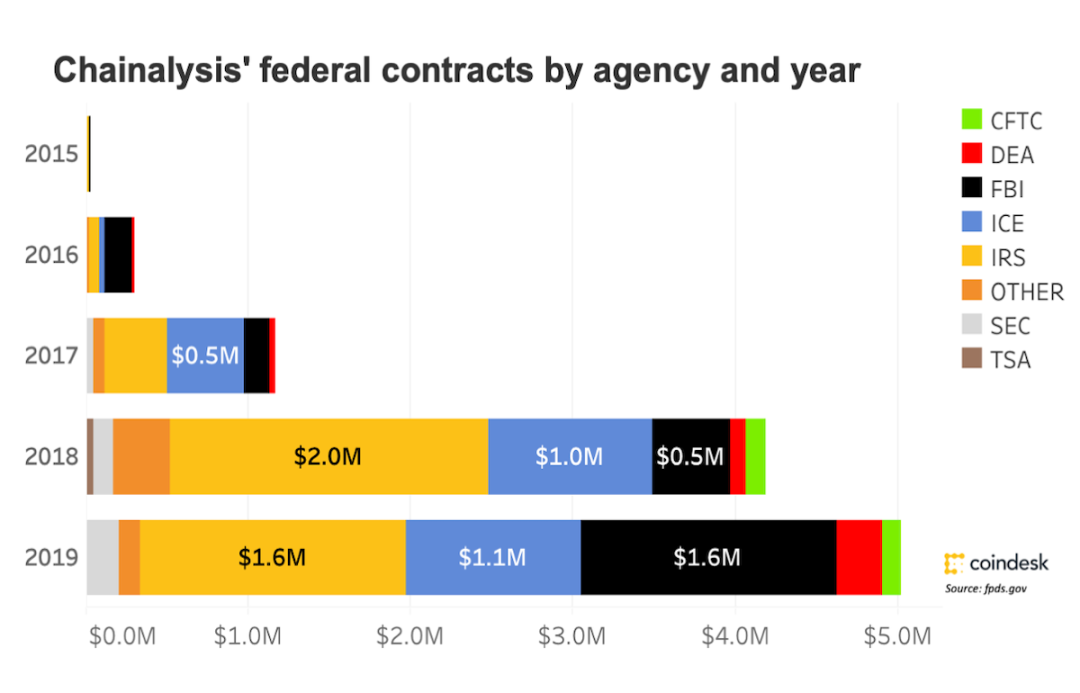 Coindesk has compiled publicly available government orders, which largely underestimate Chainalysis's actual contract amounts.
Coindesk has compiled publicly available government orders, which largely underestimate Chainalysis's actual contract amounts.
Chainalysis's early main market has been Europe and the U.S., having signed with Europol in 2016. It began to focus on entering the Asia-Pacific market in 2019, accepting a strategic investment from MUFG Innovation Partners, the largest bank in Japan. After the completion of the last funding round, Chainalysis disclosed that its revenue and client numbers in the Asia-Pacific region had both more than doubled in 2021.
Its second-largest client group consists of FinTech and crypto-native companies, including Gemini, Paxos, Bitstamp, Bitpay, Dapper Labs, Robinhood, and Square. From its product expansion path, Chainalysis is attempting to extract more value from these clients using a Land and Expand strategy.
Finally, Chainalysis's fastest-growing client group is financial institutions, which have increased by 200% over the past year to over 100, including large banks like Cross River Bank, NYC Mellon, and Barclays that are entering the crypto ecosystem or are crypto-friendly banks. Chainalysis has facilitated interaction between crypto-native companies and the entire traditional financial system, promoting compliance with anti-money laundering requirements while facilitating their account openings.
Chainalysis's clients are primarily enterprise-level, with some falling into the mid-market category. Its expansion in the SMB sector mainly relies on partnerships with other software providers, which is also the mainstream practice in the SaaS field today. Companies we studied, such as Fireblocks and Sardine, have chosen to collaborate with Chainalysis KYT when providing anti-money laundering solutions to their clients. Chainalysis's Partnership Program, officially launched in April 2020, confirmed this idea, and by March 2021, it had over 50 partners helping to distribute its products.
6: Competition: Chainalysis Enjoys the Matthew Effect
Due to the specialization of on-chain data assets and services, it is unlikely that the government will build its own solutions; Chainalysis's main direct competitors are other third-party professional service providers:
- TRM Labs: TRM focuses on serving financial institution clients, starting in 2018, historically supported by large financial investors like BVP and Tiger Global, and attracting strategic investors like JP Morgan, Amex Ventures, Visa, Citi Ventures, Jump, and PayPal Ventures (though Salesforce's founder invested in Chainalysis). It has signed clients like Uniswap, Circle, and FTX;
- Elliptic: Elliptic and Chainalysis started almost simultaneously but chose to first focus on compliance scenarios for private enterprises before seeking to enter government law enforcement scenarios, which is the opposite path of Chainalysis. It later participated in the Mt. Gox investigation but did not perform as impressively as Chainalysis. Currently, Elliptic has signed clients like Revolut, Stellar, and Spanish banking giant Santander;
- Coinbase Tracer: Coinbase Tracer packages a series of capabilities from Coinbase Intelligence and compliance, providing similar capabilities to Chainalysis Reactor and KYT, but its Go-To-Market scale and visibility are still small, and it has not shown particularly strong social determination;
- ……
Overall, this track is currently somewhat crowded but presents a pattern of one strong player and many strong competitors—Chainalysis has clear advantages in terms of capital reserves, customer resources, and data accumulation.
Similar to our observations in cases like Metamask, Fireblocks, and MoonPay, the market leader within the crypto ecosystem can enjoy a strong Matthew effect. Chainalysis has almost become synonymous with crypto compliance and, to some extent, has become the industry standard. It has the most authoritative clients, can publish the most influential reports, and has become a reference for major mainstream media when citing crypto data.
According to the CEO, Chainalysis has a large amount of cash on hand and may choose to acquire some synergistic players in the industry.
7: Conclusion: Overvaluation and the Cycles of the Crypto World are the Biggest Investment Barriers
Periods of technological transformation or when technology begins to impact the real economy are good times to invest in secure companies. Several companies that have performed well in the secondary market were those that developed cloud security products when everyone was betting on cloud computing, such as Zscaler, Cloudflare, and Okta around 2008.
Cryptocurrency and cloud computing may not be entirely analogous, but the nature of Chainalysis is indeed similar to that of security companies back then.
Like Fireblocks, which we view positively at the business level, Chainalysis is one of our favorite types of companies—essentially SaaS, serving clients in the rapidly growing crypto ecosystem. However, constrained by overvaluation and the cycles of the crypto world, the $8.6 billion Chainalysis is difficult to view as an attractive opportunity.
Its latest $8.6 billion valuation reflects the strong confidence of other investors in the market (or GIC)—even with a high estimate, based on a $200 million ARR in 2022, it still enjoys a Forward EV/ARR Multiple of over 40x. According to FACTSET data, the best high-growth SaaS companies like Snowflake, Datadog, and Crowdstrike currently have a 2022 Forward EV/Revenue Multiple of no more than 20x.
The most optimistic expectation for Chainalysis is as follows: governments in the Asia-Pacific, Middle East, Latin America, and Africa are willing to spend budgets similar to those of the U.S. government to combat illegal activities on-chain within five years, Chainalysis's new products like Business Data achieve great success while old products maintain strong NDR, then investors can expect a 3-5x return at an $8.6 billion valuation.
In the face of the reality of an ongoing bear market, Chainalysis faces reduced usage and the permanent death of some clients (such as BlockFi). Chainalysis has raised enough money, and its management team has ample experience navigating bull and bear markets, but we are currently uncertain to what extent its business itself is affected by the larger cycle—according to the founding team's experience in the 2018 bear market, New Logos will still increase, but retention may decline.










